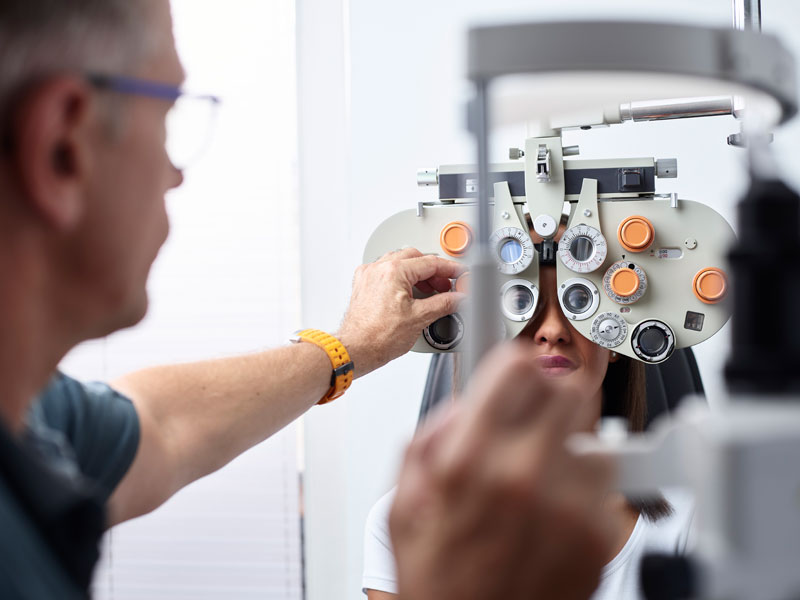Why Picking an Eye Doctor Optometrist is Important for Your Eyes
Why Picking an Eye Doctor Optometrist is Important for Your Eyes
Blog Article
Exploring the current Technological Advancements in Optometry and What They Mean for Optometrists
In the ever-evolving field of optometry, current technological advancements are reshaping how practitioners approach eye care. From the accuracy of Optical Coherence Tomography to the nuanced understandings used by AI-driven diagnostic tools, these developments are establishing new requirements in individual analysis and therapy. Teleoptometry is positioned to redefine availability, making certain that proficiency transcends geographical limitations. As these advancements permeate the practice, optometrists are confronted with the obstacle of embracing these tools to enhance patient outcomes. Yet, the concern continues to be: just how will these technological shifts redefine the functions and obligations within the career?
Innovations in Diagnostic Tools
Progressing the field of optometry, technologies in analysis devices have reinvented the means eye treatment professionals assess and detect ocular conditions and visual problems. The past decade has actually seen significant technological innovations, enabling even more comprehensive and accurate examinations. Optical Coherence Tomography (OCT), for instance, gives high-resolution cross-sectional pictures of the retina, permitting for the early discovery of illness such as glaucoma and age-related macular deterioration. This non-invasive imaging technique has actually become indispensable in modern optometric method.
An additional key development is the introduction of sophisticated corneal topography systems, which map the surface curvature of the cornea with precision. These tools are specifically beneficial for suitable call lenses and diagnosing corneal disorders. Furthermore, digital retinal imaging has changed conventional ophthalmoscopy, providing thorough, scenic views of the retina that help with detailed aesthetic examinations.
The advancement of wavefront aberrometry has additionally been crucial, making it possible for the analysis of refractive mistakes with unparalleled accuracy (Eye Doctor Optometrist). This modern technology aids in customizing corrective lenses and boosting surgical outcomes for refractive surgical treatments. Collectively, these diagnostic innovations empower eye doctors to supply remarkable person treatment, making certain very early treatment and customized therapy strategies, eventually boosting aesthetic wellness results
AI in Individual Monitoring
Structure on the structure of cutting-edge analysis tools, the unification of synthetic knowledge (AI) in person monitoring stands for a transformative jump for optometry. AI systems are significantly used to improve performance, accuracy, and personalization in patient care.
Furthermore, AI-driven platforms assist in structured person communications and administrative processes. Automated scheduling, online assessments, and individualized follow-up strategies not just boost patient satisfaction yet also enhance time monitoring for specialists. These systems can triage individuals based on the urgency of their problems, making sure that those in vital requirement obtain prompt attention.
Moreover, AI enhances decision-making by giving eye doctors with evidence-based recommendations and therapy paths. By integrating information from digital health records, AI devices use insights that inform clinical decisions, minimizing the danger of errors and improving individual end results. As AI proceeds to progress, its duty in client monitoring will likely increase, improving the landscape of optometric treatment.
Developments in Retinal Imaging
In the world of optometry, retinal imaging has actually witnessed impressive technological developments that are boosting diagnostic capacities and client treatment. Developments such as Optical Comprehensibility Tomography (OCT) and fundus digital photography have actually transformed just how eye doctors picture and assess the retina. OCT, specifically, offers high-resolution, cross-sectional photos of the retina, permitting for the thorough assessment of its layers. This capacity is important for very early detection and management of problems like glaucoma, diabetic person retinopathy, and age-related macular degeneration.
Boosted imaging modalities like OCT angiography are additional refining diagnostic precision. Opticore go Optometry. Such advancements promote the recognition of minute retinal adjustments that might indicate disease progression.
Moreover, developments in fabricated knowledge are boosting retinal imaging by making it possible for automated evaluation of big datasets. These systems help optometrists in identifying patterns a measure of pathology, consequently enhancing analysis precision and performance. Collectively, these innovations are transforming retinal imaging right into a foundation of contemporary eye care, boosting outcomes and expanding restorative opportunities.
Teleoptometry's Expanding Function
Teleoptometry is progressively becoming a crucial component of eye care, driven by advancements in data and analysis devices. As optometry welcomes electronic change, teleoptometry facilitates remote assessments, enabling eye doctors to expand their solutions beyond typical limits. This is especially useful in underserved and country areas where accessibility to specialized eye care is typically restricted. By leveraging high-resolution video conferencing and progressed retinal imaging, optometrists can perform thorough eye examinations from afar, making sure prompt diagnosis and therapy.
The integration of artificial intelligence (AI) more improves teleoptometry, enabling the analysis of visual data and aiding in the detection of ocular conditions such as glaucoma and diabetic retinopathy. AI-powered formulas can quickly interpret complicated imaging data, providing eye doctors with beneficial understandings that bolster professional decision-making.
In addition, teleoptometry sustains continuity of care with seamless combination with digital wellness documents (EHRs), enabling optometrists to keep thorough person histories. This ensures that people obtain consistent and personalized care even when talking to various professionals.
Despite these benefits, difficulties remain, consisting of making sure information safety and taking care of patient expectations. Nevertheless, teleoptometry stands for a considerable stride towards even more obtainable, reliable, and patient-centered eye treatment. As modern technology progresses, its role is positioned to expand further.

Future Trends in Eye Treatment
A myriad of cutting-edge fads is established to improve the future of eye care, driven by technical improvements and the evolving requirements of patients. One considerable trend is the assimilation of artificial knowledge (AI) in diagnostics, you can look here which assures to enhance the accuracy and performance of eye examinations. AI formulas can evaluate large amounts of information from retinal images, potentially discovering problems like diabetic person retinopathy and glaucoma earlier than standard methods.
Moreover, personalized medication is getting traction in optometry, with hereditary screening notifying personalized treatment plans. This method intends to maximize individual end results by customizing treatments to specific genetic profiles. Wearable modern technology, such as clever contact lenses, is likewise imminent, providing real-time monitoring of intraocular pressure or glucose levels, therefore providing continuous understandings into systemic and ocular health.
The adoption of increased reality (AR) and online fact (VR) in training and individual education and learning is another emerging fad. These innovations offer immersive experiences that can boost understanding and abilities both for clients and eye doctors. As these fads develop, optometrists should remain abreast of technological developments to supply cutting-edge care, making certain enhanced patient results and satisfaction in the dynamic landscape of eye treatment.
Verdict

Collectively, these diagnostic improvements equip optometrists to provide premium person care, guaranteeing very early treatment and tailored therapy methods, eventually improving visual health and wellness end results.

As these technologies proceed to advance, optometrists have to adjust and include them into practice, eventually optimizing process efficiency and boosting the requirement of eye treatment provided to individuals.
Report this page